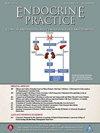Risk Factors, Microbiology, and Prognosis of Diabetic Foot Osteomyelitis: A Retrospective Cohort Study
IF 3.7
3区 医学
Q2 ENDOCRINOLOGY & METABOLISM
引用次数: 0
Abstract
Objective
To determine risk factors, microbiology, and prognosis of diabetic foot osteomyelitis (DFO).
Methods
We conducted a retrospective cohort study of 456 persons diagnosed with diabetic foot disease admitted to a grade-A tertiary hospital from January 2012 to December 2022. Multifactorial Cox regression was used to analyze independent risk factors for DFO. Medical records were reviewed to determine etiologic agents and antibiotic susceptibility profiles. In addition, 5-year survival rates of all DFO patients and those undergoing amputation were analyzed using Kaplan-Meier curves.
Results
Multivariate Cox regression identified higher Wagner grades (hazard ratio 3.17, 95% confidence interval 2.04, 4.94) as independent risk factors for DFO. In the DFO group, a total of 62 patients had positive bone or deep tissue cultures. The most prevalent Gram-positive bacterial isolates were Staphylococcus aureus (11.29%) and Enterococcus faecalis (11.29%), while Gram-negative infections were caused most often by Proteus vulgaris (4.84%). Polymicrobial infections were common (27.41%). Five-year survival rates were lower among DFO patients than in matched DF controls, and lower among major amputation than minor amputation and nonamputation DFO patients.
Conclusions
Higher Wagner grades were independent risk factors for DFO. Major amputation does not improve 5-year survival rates in DFO patients.

糖尿病足骨髓炎的危险因素、微生物学和预后:一项回顾性队列研究。
目的:探讨糖尿病足骨髓炎(DFO)的危险因素、微生物学及预后。方法:我们对2012年1月至2022年12月在某三级甲等医院就诊的456例诊断为糖尿病足(DF)的患者进行回顾性队列研究。采用多因素Cox回归分析DFO的独立危险因素。医疗记录的审查,以确定病原和抗生素敏感性档案。此外,使用Kaplan-Meier曲线分析所有DFO患者和截肢患者的5年生存率。结果:多因素Cox回归发现较高的Wagner分级(HR 3.17, 95% CI 2.04, 4.94)是DFO的独立危险因素。在DFO组中,共有62例患者骨或深部组织培养阳性。革兰氏阳性菌以金黄色葡萄球菌(11.29%)和粪肠球菌(11.29%)最为常见,革兰氏阴性菌以普通变形杆菌(4.84%)最为常见。多微生物感染常见(27.41%)。DFO患者的5年生存率低于匹配的DF对照组,大截肢患者的5年生存率低于小截肢和非截肢DFO患者。结论:较高的Wagner分级是DFO的独立危险因素。大截肢不能提高DFO患者的5年生存率。
本文章由计算机程序翻译,如有差异,请以英文原文为准。
求助全文
约1分钟内获得全文
求助全文
来源期刊

Endocrine Practice
ENDOCRINOLOGY & METABOLISM-
CiteScore
7.60
自引率
2.40%
发文量
546
审稿时长
41 days
期刊介绍:
Endocrine Practice (ISSN: 1530-891X), a peer-reviewed journal published twelve times a year, is the official journal of the American Association of Clinical Endocrinologists (AACE). The primary mission of Endocrine Practice is to enhance the health care of patients with endocrine diseases through continuing education of practicing endocrinologists.
 求助内容:
求助内容: 应助结果提醒方式:
应助结果提醒方式:


